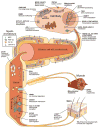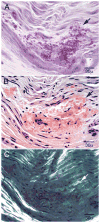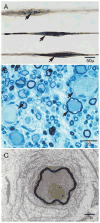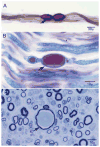Inherited neuropathies: clinical overview and update
- PMID: 23801417
- PMCID: PMC3918879
- DOI: 10.1002/mus.23775
Inherited neuropathies: clinical overview and update
Abstract
Inherited neuropathy is a group of common neurologic disorders with heterogeneous clinical presentations and genetic causes. Detailed neuromuscular evaluations, including nerve conduction studies, laboratory testing, and histopathologic examination, can assist in identification of the inherited component beyond family history. Genetic testing increasingly enables definitive diagnosis of specific inherited neuropathies. Diagnosis, however, is often complex, and neurologic disability may have both genetic and acquired components in individual patients. The decision of which genetic test to order or whether to order genetic tests is often complicated, and the strategies to maximize the value of testing are evolving. Apart from rare inherited metabolic neuropathies, treatment approaches remain largely supportive. We provide a clinical update of the various types of inherited neuropathies, their differential diagnoses, and distinguishing clinical features (where available). A framework is provided for clinical evaluations, including the inheritance assessment, electrophysiologic examinations, and specific genetic tests.
Keywords: ataxia; cerebellum; neuropathy; spinocerebellar; triplet repeats.
Copyright © 2013 Wiley Periodicals, Inc.
Figures







References
-
- Dyck PJ, Oviatt KF, Lambert EH. Intensive evaluation of unclassified neuropathies yields improved diagnosis. Ann Neurol. 1981;10:222–226. - PubMed
-
- Chahin N, Zeldenrust SR, Amrami KK, Engelstad JK, Dyck PJ. Two causes of demyelinating neuropathy in one patient: CMT1A and POEMS syndrome. Can J Neurol Sci. 2007;34:380–385. - PubMed
-
- Chaudhry V, Chaudhry M, Crawford TO, Simmons-O’Brien E, Griffin JW. Toxic neuropathy in patients with pre-existing neuropathy. Neurology. 2003;60:337–340. - PubMed
-
- Dyck PJ, Kratz KM, Karnes JL, Litchy WJ, Klein R, Pach JM, et al. The prevalence by staged severity of various types of diabetic neuropathy, retinopathy, and nephropathy in a population-based cohort: the Rochester Diabetic Neuropathy Study. Neurology. 1993;43:817–824. - PubMed
-
- Triggs WJ, Brown RH, Jr, Menkes DL. Case records of the Massachusetts General Hospital. Case 18-2006. A 57-year-old woman with numbness and weakness of the feet and legs. N Engl J Med. 2006;354:2584–2592. - PubMed
Publication types
MeSH terms
Grants and funding
LinkOut - more resources
Full Text Sources
Other Literature Sources
Medical

